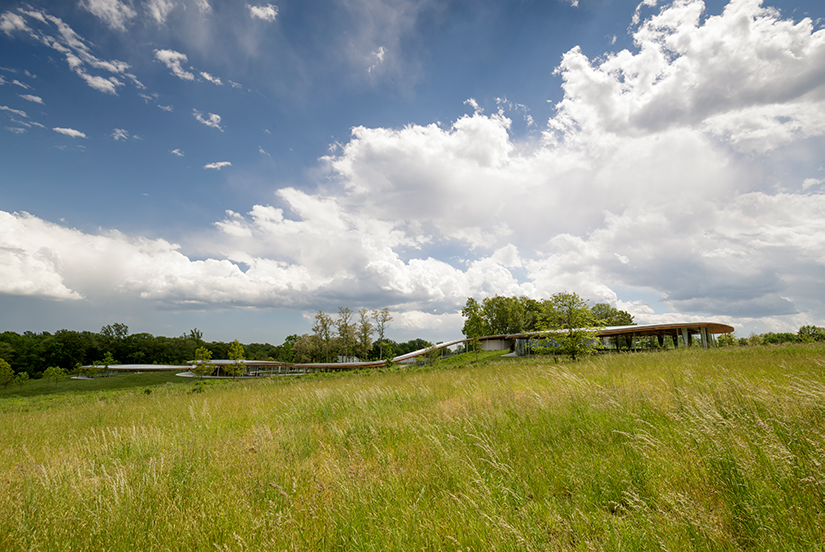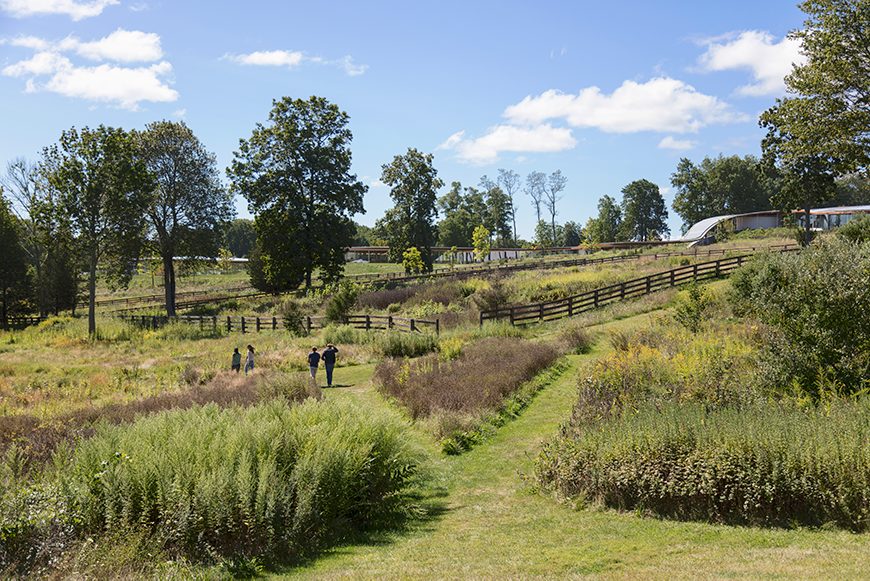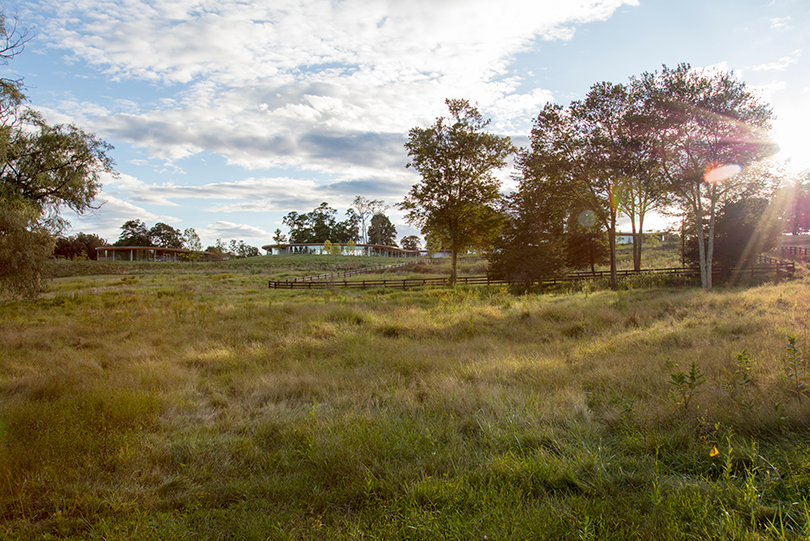Topics
The importance of bees as pollinators is central to sustaining our complex ecological systems. But other pollinators, including native bees, butterflies, hummingbirds, moths, beetles, bats, and other small mammals, are also essential to our survival. Collectively, they move pollen among flowering plants, fertilizing them in search of food or nectar; in the process produce seeds, fruits, and vegetables. Most of the focus has been on the European honey bee, Apis mellifera, and its decline, because it dominates global crop pollination.
But as we’ve become more aware of the role pollinators play in our lives, particularly native pollinators, a movement across the country has emerged to build pesticide-free public and private pollinator pathways – native habitat highways to support the pollinators. Grace Farms Foundation, in partnership with The Nature Conservancy, in Connecticut, are also joining the pollinator pathway movement. In a Q&A with Mark Fowler, Grace Farms’ former Nature Initiative Director, he discusses pollinators and native plants to build pollinator pathways. On April 27, Grace Farms and The Nature Conservancy, will co-host a day-long event for children and adults that celebrates Earth Day and explores the importance of pollinators and “Restoring Wild.”
Q: What are pollinator pathways?
In Fairfield County, there is a major pollinator pathway movement and we are a part of it. There are now over 25 towns and cities involved and they are connecting towns through pollinator corridors, so that wildlife and pollinators can be connected and spread amongst all these towns. These connected pollinator pathways, also known as wildlife habitat corridors, provide food and habitat for bees, butterflies, birds, and wildlife.
It’s an amazing grass roots movement and we want to help build awareness about the importance of planting native plants to create biodiversity and support pollinators. By planting native plant meadows, here at Grace Farms, we’ve been able to bring back pollinators to the land.
We partnered with The Nature Conservancy because they are one of the most trusted nature organizations in the world to get this message out about restoring native plants and pollinators. In big cities the Conservancy is planting pollinator gardens on top of buildings. They are taking areas that are abandoned lots and putting in pollinator gardens. Both of our organizations want to inspire the public that they too can bring back the bees, the butterflies, the birds by establishing native, wildlife habitats and pathways.
Collectively, I believe we can have a major impact.

Grace Farms’ award-winning River building designed to naturally align with nature and the landscape © Julien Jarry
Q: What has Grace Farms planned for Earth Day?
A: We will have pollinator pathway representatives teaching people about the importance of using native plants. They can be planted in a pot on your back porch or deck of your apartment. We’ll also be discussing how to establish a native meadow in your backyard. We have programing for kids and will teach them about building native habitats. There will be native bird walks; native wildlife; and conversations about the benefits of restoring wild habitats.
I’ll also be joining Pascal Mittermaier, [Global Managing Director of Cities at The Nature Conservancy] on Friday [April 26] to talk about how we can transform our cities and build thriving communities.
One of our missions is to reconnect kids and adults to nature. No one is spending enough time outside. Per day, kids, on average, are spending three to seven minutes outdoors of un-programmed play, compared to seven-and-a-half hours in front of a screen. So through this restoring wild initiative we hope to inspire people to get outside and be part of the solution. We will provide people with a pack of native seeds that they can plant and by this summer, people can have native plants growing on their property. That’s being part of the solution.
Q: What does “Restoring Wild” mean?
We see restoring wild as a call to action.
About 75 percent of our earth has been degraded. We don’t have to restore it into a pristine state, but we want to take areas that we have been degraded and bring them back to a healthy state. We are never going to go back to a pristine ecosystem, but we can take degraded areas and bring them back to where humans and wildlife can thrive together. One of best local restoration examples is Long Island Sound.
Thirty years ago, Long Island Sound in the 1980s, was a cesspool: there was medical waste, sewage, trash. It became this dumping ground. Within 30 years we have turned the Sound around. We now have whales coming back and the bait fish back, too. We have seals, dolphins, sharks, even sea turtles are coming back.
It’s incredible the amount of life coming back because we have severely limited all the sewage and waste going into the Sound. That is serious ecological restoration.
Q: Can you discuss “Restoring Wild” at Grace Farms?
A: When I began as the Nature Initiative Director in 2016, I saw the beauty and power in transforming the land into native meadows. The vision to restore about 70 percent of the land was led by our Chair and President, Sharon Prince, and we turned pasture for horses into a very diverse eco-system. We now have 25 species of native plants per square foot in our meadows. We also have 88 species of birds confirmed that thrive at Grace Farms. That’s a result of bringing back the native habitat.
Q: What are native plants and why are they important to pollinators?
Native plants are indigenous to the region. Wildlife and pollinators evolved alongside them and so they have this beneficial relationship where they support the life-cycle of many beneficial insects, birds, bees, and other wildlife.
Ideally, the plants you want to plant are native pollinator-friendly plants. Many of the plants we have in our backyards and communities can be non-native plants imported from other countries. They can be very invasive and crowd out native plants. If we use more native plants in our landscape and gardens it will increase bio-diversity exponentially and can improve and nurture the environment for all living things, including humans.

Grace Farms’ native meadows © Sahar Coston-Hardy
Q: What does biodiversity mean?
The term biodiversity comes from the combination of “biological & diversity” and it’s about the diversity of living species on Earth. It’s a complex set of eco-systems that includes every form of living organism. E.O. Wilson, the “father of biodiversity” and one of my hero’s says: “It is easy to overlook the services that conserved eco-systems provide to humanity. They enrich the soil and create the very air we breathe. Without these amenities, the remaining tenure on Earth of the human race would be nasty and brief.” That’s an excerpt from Wilson’s book The Diversity of Life.
Q: What is the biggest threat to pollinators?
A: It’s a combination of factors, including habitat loss, pollution, pesticides, climate change, diseases, and parasites. We think pesticides and climate change are among the biggest threat to pollinators, but the largest threat to all wildlife and pollinators is habitat loss. Just between 1982 and 2001 alone, a minimum of 6,000 acres a day in the United States were lost to development. So, habitat loss is one the biggest threats to our wildlife and to our pollinators.
Connecticut alone is losing about 3,700 acres of forest a year to development and New England is seeing its woodlands disappear at a rate of nearly 24,000 acres of forest each year, or 65 acres a day. Each time this happens, we are adding massive amounts of lawn to suburban development. It’s a monoculture species that has no value to pollinators. It’s a green desert.
This habitat loss has contributed to the decline of pollinators. The native [rusty patched] bumble bee, [Bombus affinis] has plunged nearly 90 percent since the late 1990s. This pollinator is now on the endangered species list in the United States. I remember seeing so many bumble bees growing up and it’s such an essential pollinator of wildflowers and some of our crops. About a third of U.S. crops, from blueberries to tomatoes, are pollinated by bumble bees. Increases in pesticides, pathogens, loss of habitat and food supply, are why the [rusty patched] bumble bee has declined.
In general, we are seeing a decline of native bee species in the Northeast and these wild bee species are important pollinators for local crops such apples, blueberries, and cranberries.
In Connecticut, alone, we have over 300 species of bees.
Q: Why do you consider lawns a “green desert?”
Our lawns cover over 40 million acres in our country and are a biological desert. In order to keep our green lawns alive, we put over 90 million pounds of pesticides and 75 million pounds of fertilizers on our lawns each year. Lawn is generally a non-native monoculture species and has zero biodiversity. I have heard it said that to keep our lawns healthy and green we need to put them on artificial life support, so we have to dump chemicals onto the lawn to keep them a green desert.
We are basically poisoning our environment and communities.
There is also the issue of using lots of water on own lawns. Landscape irrigation accounts for about one-third of our water use, totaling nearly 9 billion gallons per day nationwide. Just in Connecticut, we have over 250,000 acres of lawn to water.
The grass on lawns have about one inch of roots. So, when it rains, the pesticides and chemical fertilizers flood down into our rivers because there isn’t a significant root system to absorb the runoff. Many of the native plants have roots up to 20 feet deep. Grasses and native plants that are indigenous to the area have a greater ability to absorb rain and runoff pollutants, and they don’t need a lot of water, chemicals or fertilizers to thrive.
In addition, massive amounts of carbon can be absorbed into the soil, too. This is called a carbon sequestration – the process of capturing carbon dioxide from the atmosphere and storing it in soil and plants. Carbon dioxide is the biggest issue in global warming and plants and trees and shrubs are the best solution, because they can absorb it and naturally store it. Our forests, woodlands, and native habitats can mitigate carbon dioxide emissions and on a global level, we could sequester one-third of all carbon dioxide emissions just by restoring ecosystems and habitats.
Compared to our lawn, native plants don’t require a lot of water because they are adapted to local environmental conditions and once they are established they require little maintenance.
Conserving water will also help with droughts. It’s no longer California or the arid Southwest that has droughts. We had a drought in Norwalk, Connecticut last summer. Actually, two years in a row. We are also not getting that much snow anymore, and in the Northeast we are not set up with reservoirs like the Southwest that often deal with droughts.

Grace Farms’ native meadows © Sahar Coston-Hardy
Q: Why do you think we should be hopeful?
Every day we hear that the world is falling apart due to global warming. This doomsday messaging is horrible. When we are hopeless, we aren’t going to care or want to be part of the solution. We just give up, when all we here is doomsday messaging.
Instead, we can be part of the solution by planting native plants – it could be in parts of our lawn, in our garden, in planters, in community gardens, apartments complexes, and in our cities. Part of the restoration is connecting with nature again; restoring our human relationship with nature. Guess what, if you take a pack of seeds and plant some native plants it’s a great start. It’s a beautiful way for us to have a positive relationship with nature, and if we do so collectively, we can have a major impact. Nature can start to thrive and our quality of life can improve, too.
I think the restoration movement is a hopeful message – we are restoring nature and while we may not bring nature back to its pristine state, we can make nature and our own habitat healthy again.
So, yes, restoring wild is a hopeful message. Let’s get out there and restore mother nature and our future together.
Sign up for our newsletter to learn more about Grace Farms’ ongoing programing and our initiatives: nature, arts, justice, community, and faith.

